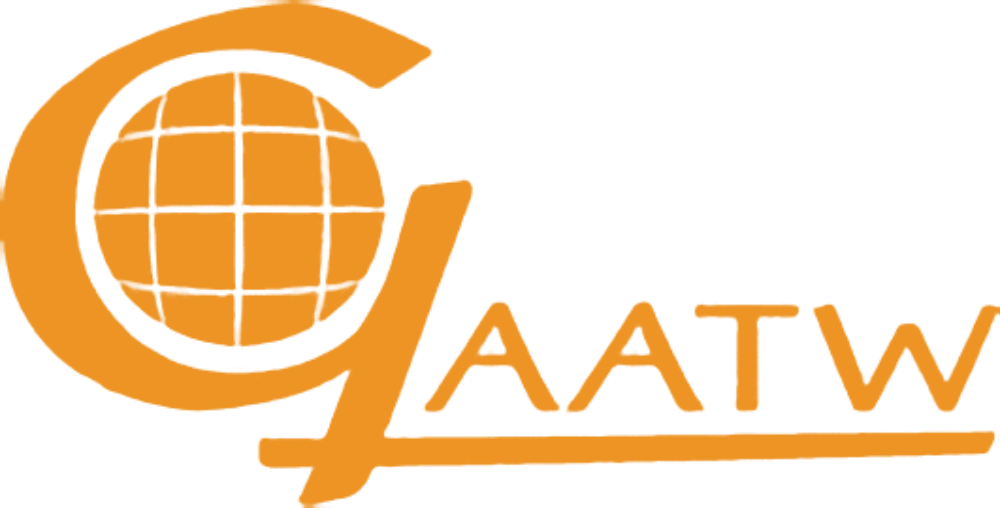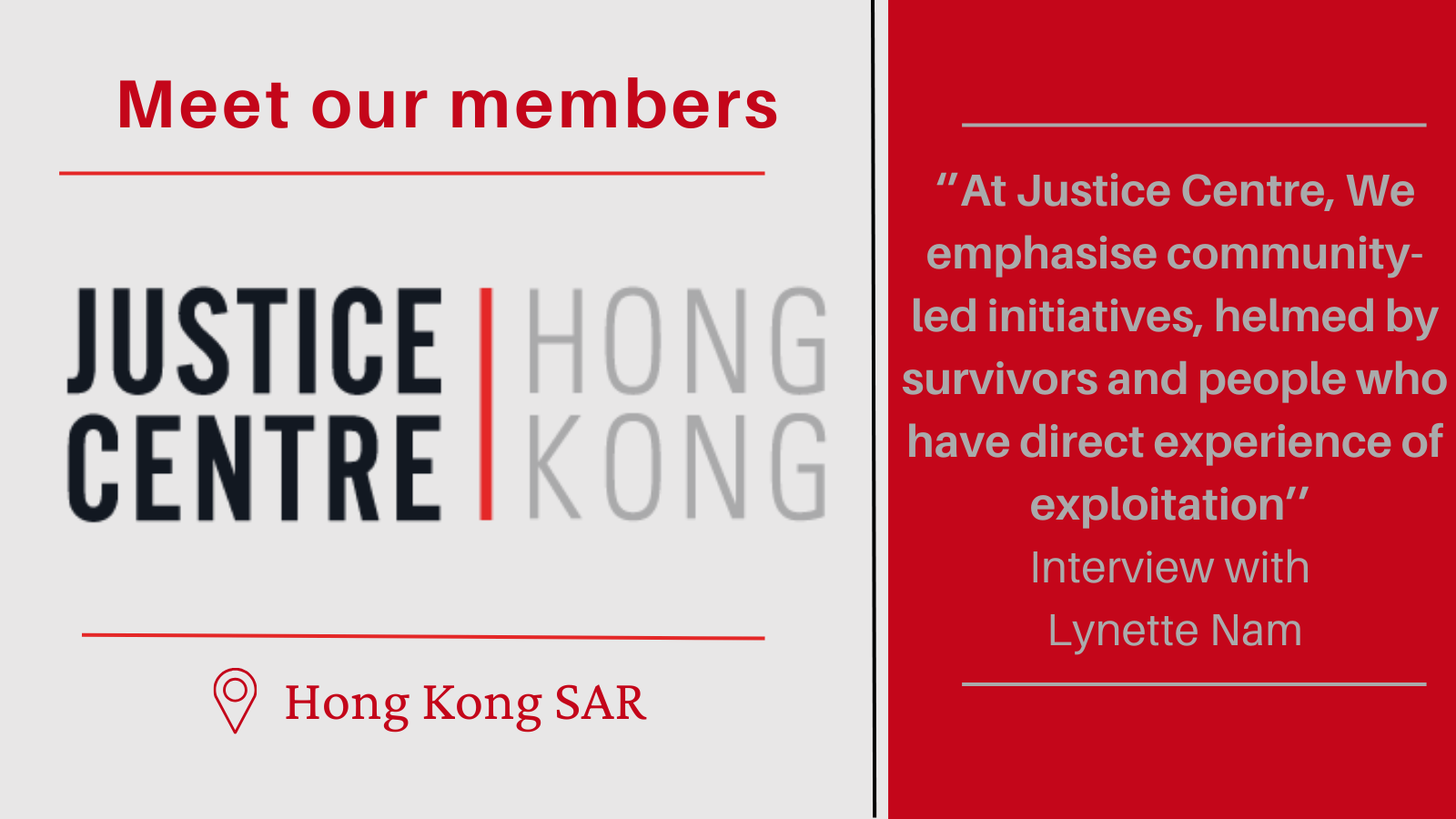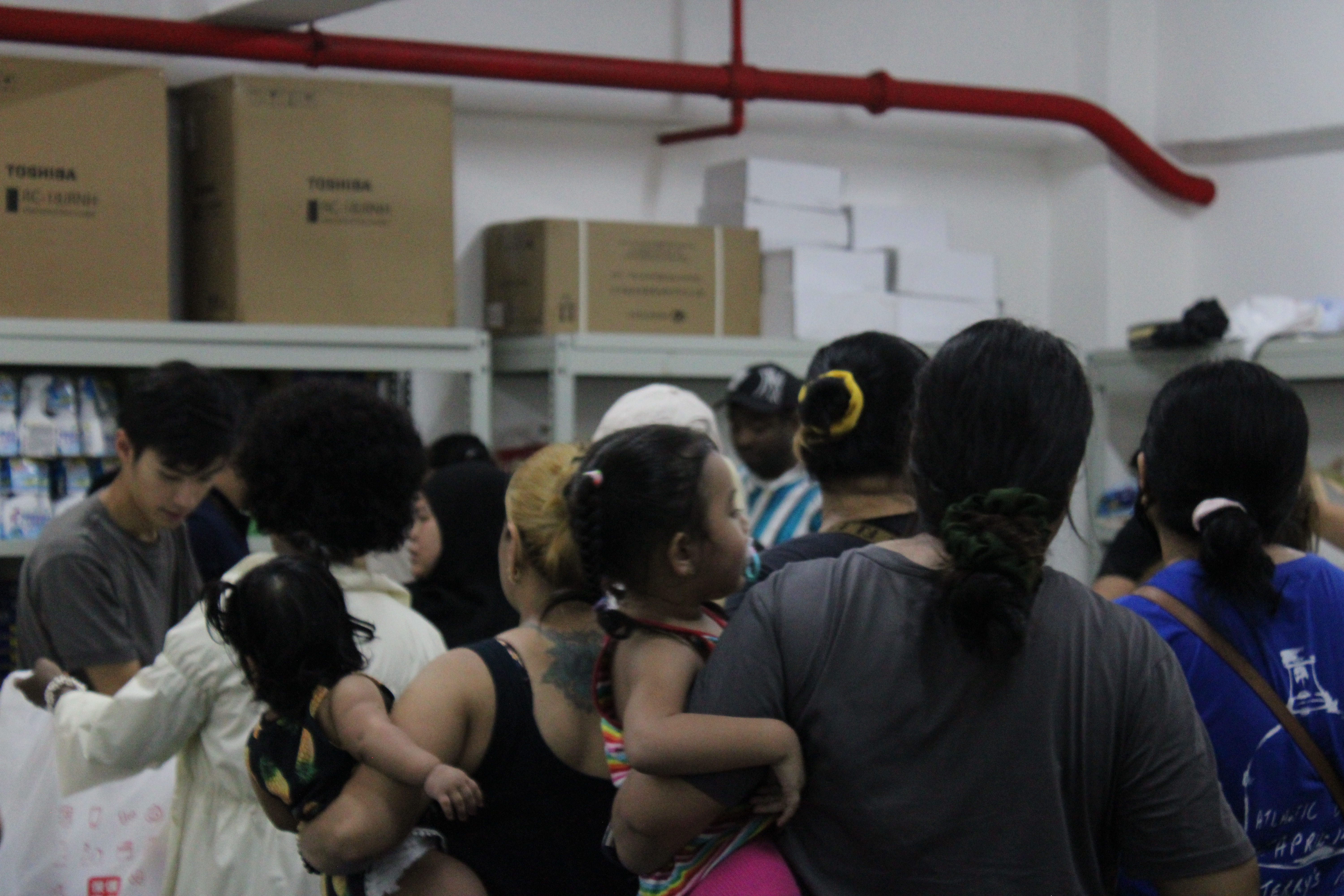Justice Centre Hong Kong is a non-profit organization that provides support to refugees, asylum seekers and victims of human trafficking in Hong Kong SAR. They help these groups to access social welfare and psychological support, as well as legal assistance. Vivian Cartagena, Programme Officer Alliance Strengthening had a interview with Lynette Nam, Executive Director at Justice Centre Hong Kong.
Vivian: Welcome Lynette to this ‘’Meet our Members” interview. I would like to know more about the history of how and why was Justice Centre Hong Kong founded?
Lynette: Justice Centre Hong Kong was formed in 2007. We were then known as the Hong Kong Refugee Advice Centre. Our main focus at that time was to provide legal aid to people who were arriving in Hong Kong and approaching the UNHCR for refugee protection. Later, in 2014, we became Justice Centre because at that time the Hong Kong government took up the responsibility of considering protection needs for people who were experiencing persecution, torture, and cruel, inhuman, degrading treatment or punishment as laid out in the Refugee Convention, the International Covenant on Civil and Political Rights and the Convention Against Torture.
What was interesting was that the Court held that, despite the express immigration exclusion within the Bill of Rights, where a right is absolute and non-derogable and if someone is at risk of that right being violated, then they should be protected. So, we were looking at an expanded set of rights, which include the prohibition of slavery and servitude. To respond to these developments, we decided to expand our work to encompass these areas and since then we have been providing legal assistance to people seeking protection in Hong Kong. We take a very holistic approach because we realise that for people to navigate legal processes, they need to have access to welfare services, rehabilitation, and ways to regain a sense of agency as well. When we work with people, we see them as a whole person, not just as someone who is going through a legal process.
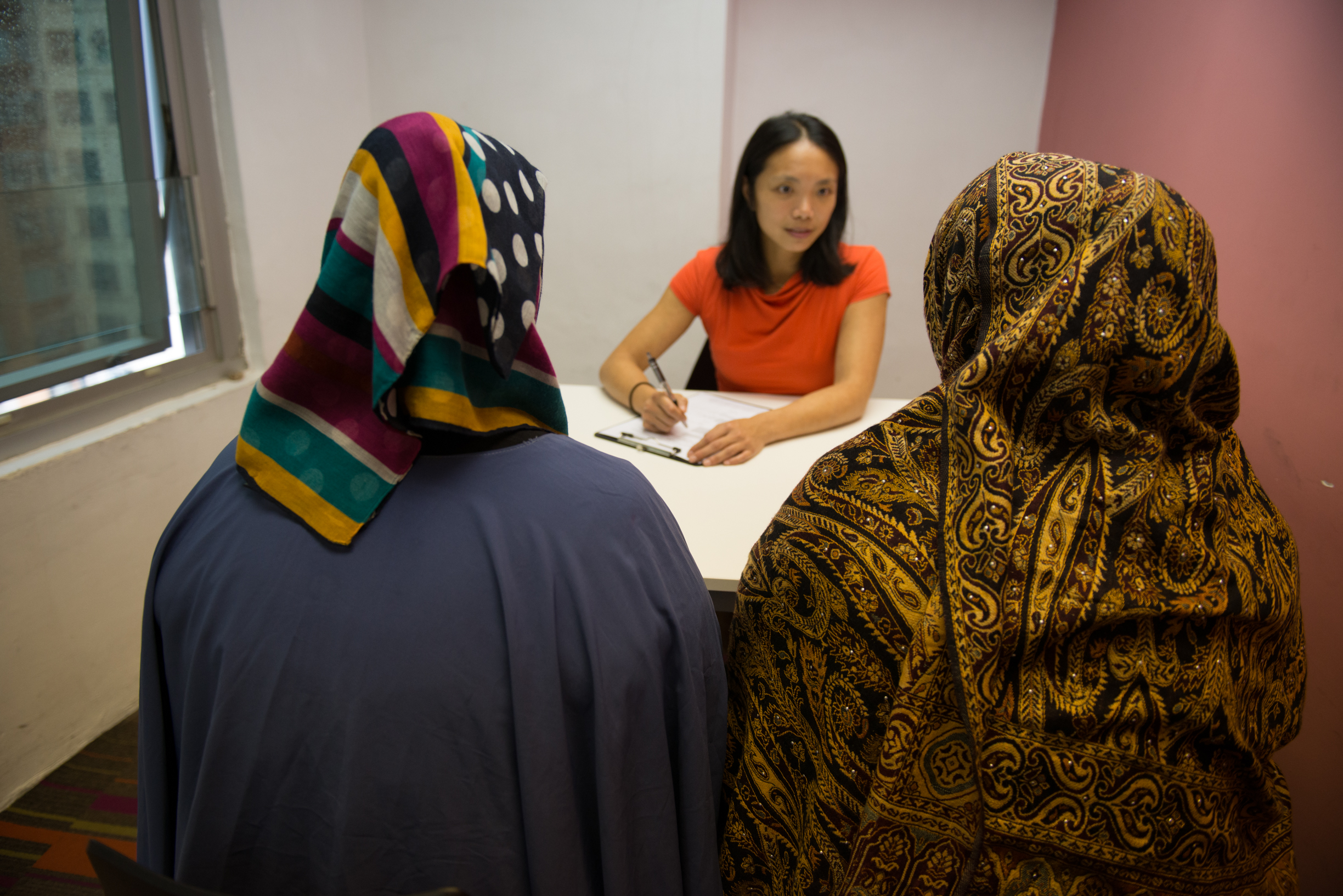
Vivian: Right, can you tell me more about how Justice Centre started working within the anti-trafficking sector?
L: I think for us it was clear that migration, asylum, and trafficking are intersecting. Migrants and refugees who have worked with us have experienced trafficking and have had rehabilitation and remedial needs because of those experiences. We expanded our research to look at migrant domestic workers in Hong Kong and their experiences of forced labour or trafficking, and we released a report in 2016 with new findings on the prevalence of forced labour and trafficking among migrant domestic workers. We also conducted research and released a report in December 2017 on the nexus between asylum and trafficking.
Through our casework and research, we encountered firsthand how unhelpful it is to put people in “categories”. Rather we need to recognise the whole spectrum of human experiences in the context of global migration, and the myriad intersecting identities.
Vivian: With regard to this integral service and assistance, did you start to articulate them with other organisations or other entities from the government?
L: When we released the report on the prevalence of human trafficking among migrant domestic workers, we mobilised civil society groups around the issue and brought together the anti-trafficking taskforce in Hong Kong to promote common standards in identifying people who have experienced trafficking. We aimed to promote adoption of international best practices in terms of early identification, making sure that civil society actors across the city were using those standards. We were able to connect with civil society groups and government officials.
We strongly believe that we must have a cross-sector perspective, and work in partnerships with the civil society, and the public and private sectors as well.
Vivian: Right, that’s a very useful strategy within anti-trafficking work. What are the main challenges that migrant domestic workers face with regard to human trafficking?
L: One of the enduring challenges is that these groups are under-identified. This is the case given people tend not to self-identify. And sometimes when people present themselves to an organisation, they may still be under some form of control or coercion. So, it’s extremely difficult to work in a way that balances best interest of the person, their agency, as well as the expectation of a positive outcome. This can lead to difficulties in establishing a trust relationship. Another difficulty is being able to offer a space where people feel they can be open and frank and still be safe. We have to acknowledge that.
Beyond this, globally and locally, the use of the rights-based approach has become increasingly marked by tensions. We are also trying to counteract very strong negative narratives around refugees and migration that have become prevalent. All this presents significant difficulties when you’re advocating for marginalised communities. Gaining public support around these issues is not easy.
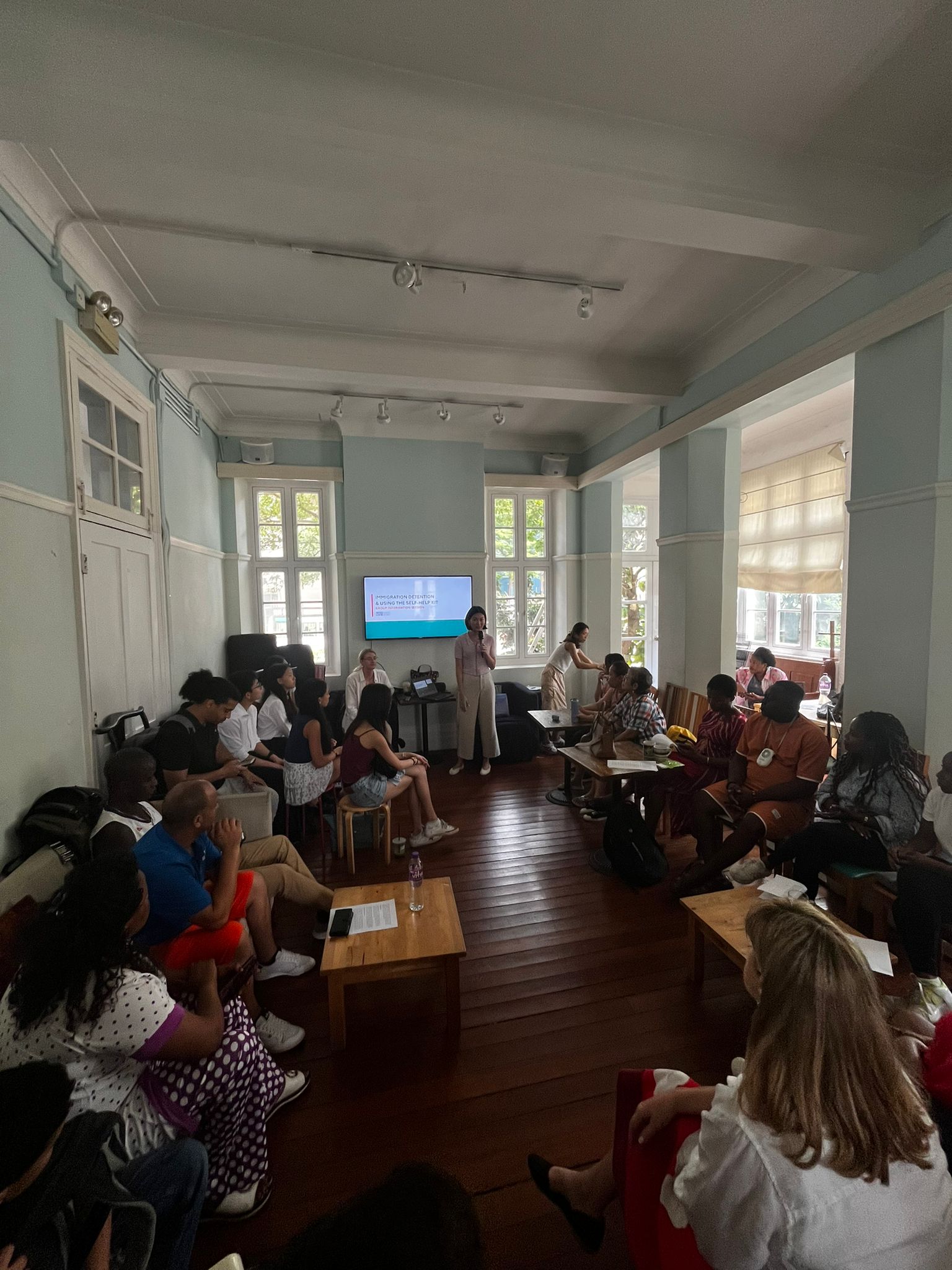
Vivian: Those are very tough challenges, especially the negative narratives that are constantly increasing nowadays. How does the Justice Center overcome those challenges?
L: We overcome those challenges by first always ensuring that we don’t come with assumptions. Our lawyers and care workers listen in a way that doesn’t immediately offer solutions. You need to listen and build trust before you actually understand the scope of an issue. We work collaboratively and offer training and resources to legal professionals, interpreters, mental health and medical practitioners, to grow a professional ecosystem that takes a people-centred approach. We also emphasise community-led initiatives, helmed by survivors and people who have direct experience of exploitation. For example, we started a project last year to develop a resource for lawyers; it is co-led by people who have experienced trauma and displacement, including people who have experienced trafficking. We worked with community consultants with different lived experiences of displacement and exploitation to co-design the scope of the project and its methodology, to understand people’s experiences of the legal system. The resource will be offered to professionals working with people who are handling cases of human trafficking, sexual violence, or other forms of trauma. Instead of writing it from a lawyer’s perspective, we felt it was important to write it in partnership with people who have had direct experience of the systemic barriers.
Coming back to your question, we seek to overcome negative narratives by building communities. We try to empower affected communities while developing a professional ecosystem that puts people at the centre.
Vivian: That’s a very strategic way to incorporate the perspectives of the groups that you work with. In this scenario, does the Justice Center focus more on a specific group of people, i.e. women?
L: We work with all groups that are in a vulnerable situation, but women specifically are the focus in a lot of our projects. Some of our strategic thematic priorities include gender-based violence (GBV) and children affected by displacement and migration. Also, we are working on some strategic cases where statelessness is at issue, which increases people’s vulnerability to exploitation.
GBV is a big thematic priority for us. We normally identify and end up taking more cases that involve women, but no, we do not exclusively work with women. We work with the full spectrum of people affected by displacement.
Vivian: Also, the assistance to those groups depends on the nature of the issue, e.g. gender-based violence, sexual exploitation, labour exploitation, etc. Actually, one of the strengths of our members is their ability to work with diverse groups. In this regard, as a GAATW member, what do you see as the key benefits of being part of this alliance?
L: It is very important for us. First of all, when you work in a national or local context, it sometimes feels isolating. A global movement offers solidarity and support. But what is most important for us when deciding which alliances to be a part of, is the ability to learn from colleagues and draw from best practices and trends from other places, and to hear about what other people are doing – their successes and their learnings. There are amazing people out there who have devoted and dedicated their professional lives to ensuring that victims of trafficking are able to access their rights. We see ourselves as a learning organisation – we believe we must always learn in order to grow. So, being part of an alliance such as GAATW gives us the opportunity to learn from others and that is incredibly important for us.
Vivian: Yes, there is also peer-support which is sometimes very much needed, especially in tumultuous times like these.
L: Absolutely, yes!
Vivian: I don’t have any more questions. Is there anything you’d like to add about the work that you want to do in the future?
L: Well, our current strategic plan takes us to mid-2026, so we will be entering a period of intense strategic thinking soon. I think that participation is fundamental to us. It has taken over a year for us to start implementing initiatives that truly incorporate meaningful participation. It is particularly important to bring in perspectives of people who have been trafficked, not just as feedback, but in the very design of projects.
We are still in the beginning phases of building our advisory committee of people with lived experience of global migration issues. So we have a spectrum of expertise when reviewing and designing our programmes and measuring our success. When we started setting up this committee, we realised that you have to build trust, offer opportunities for professional development before you ask people to commit to sharing their time and expertise. We have spent the last two years taking the initial steps. This will continue to be a focus for us as we look to the future.
Vivian: Thank you very much for your time, Lynette. It was a pleasure learning more about the Justice Center’s work and your future plans!
